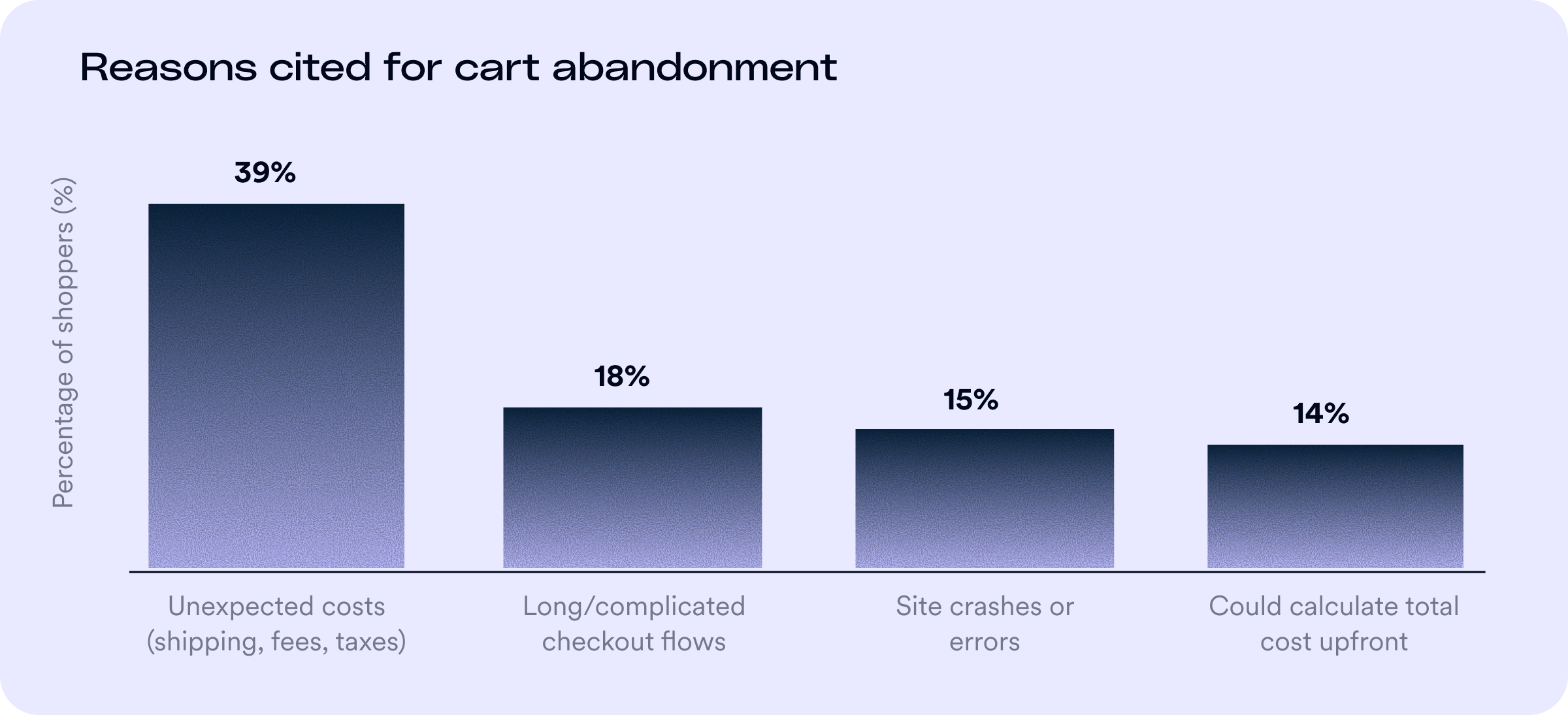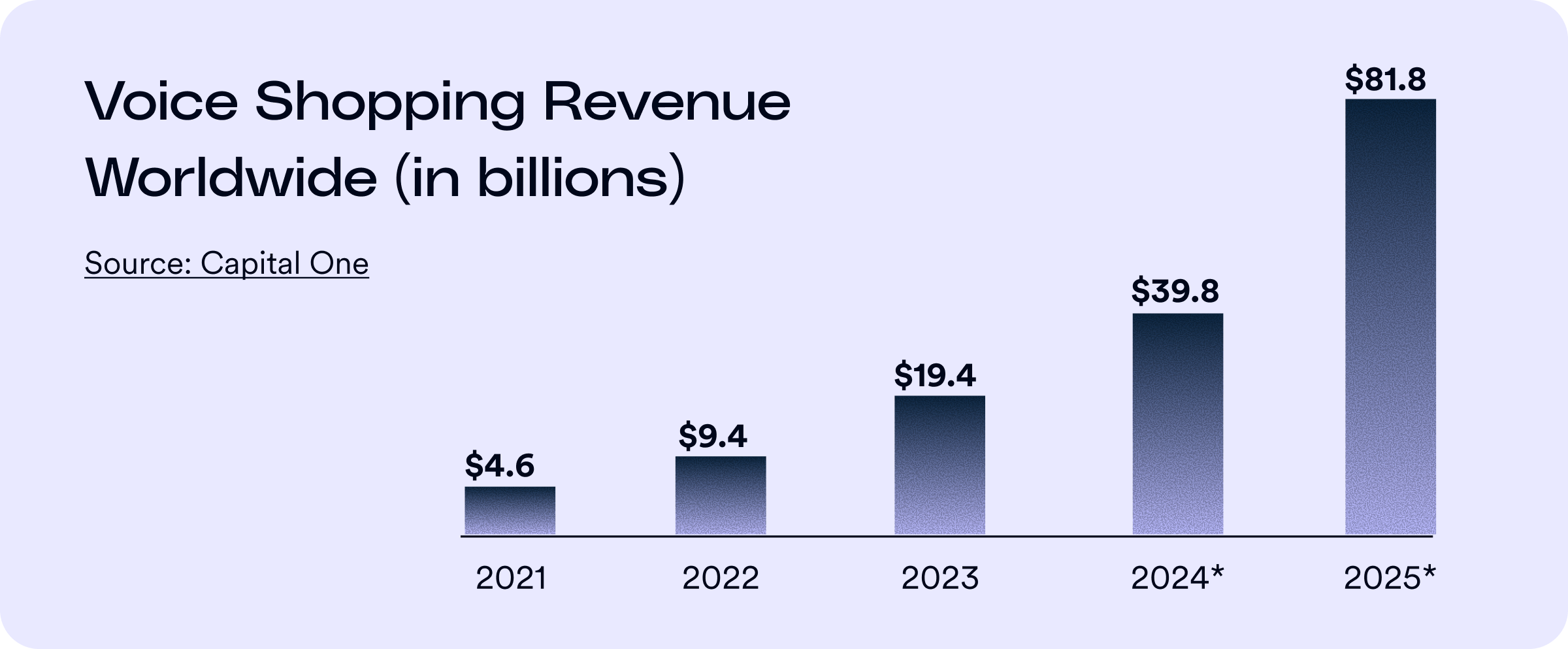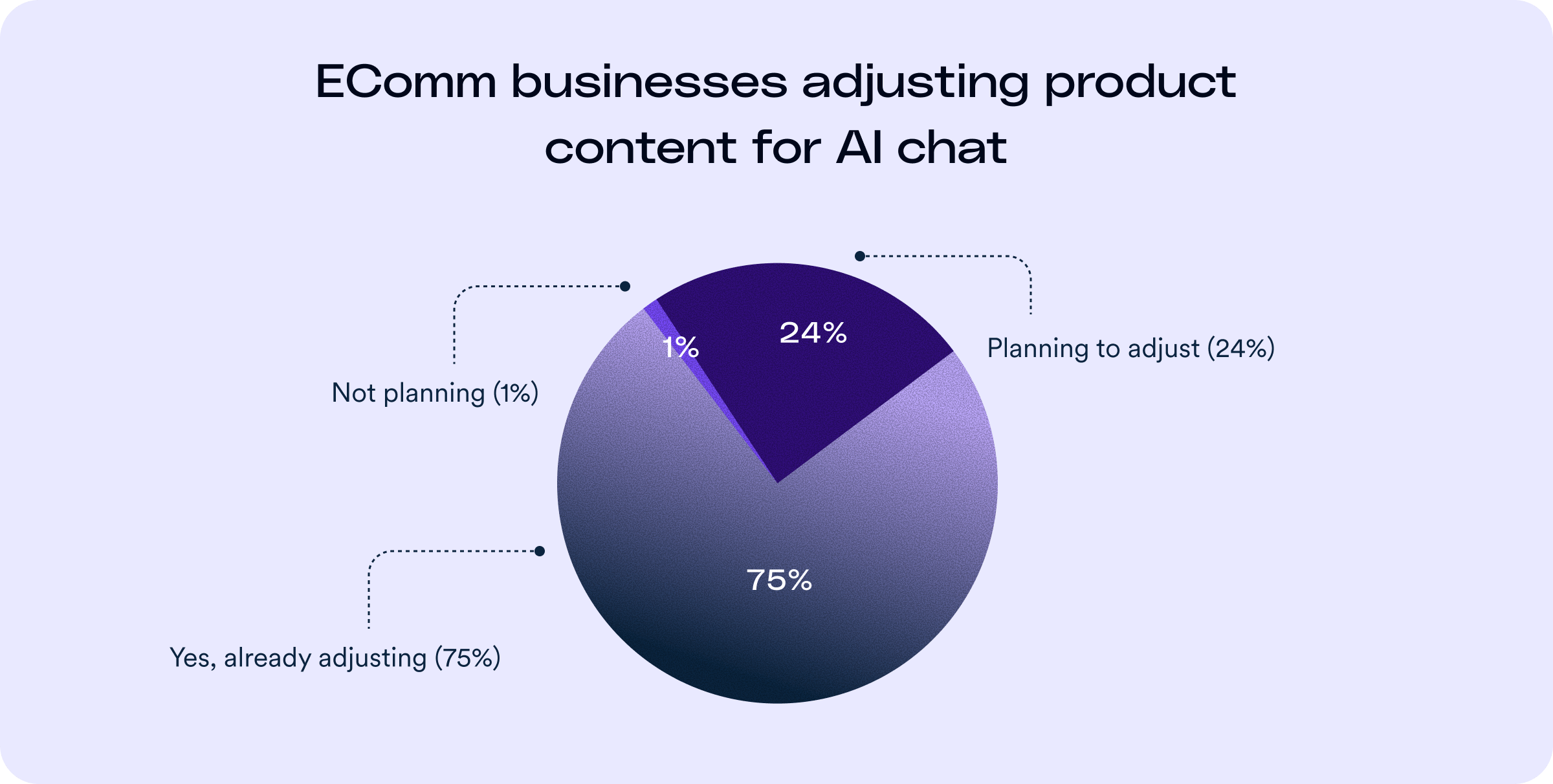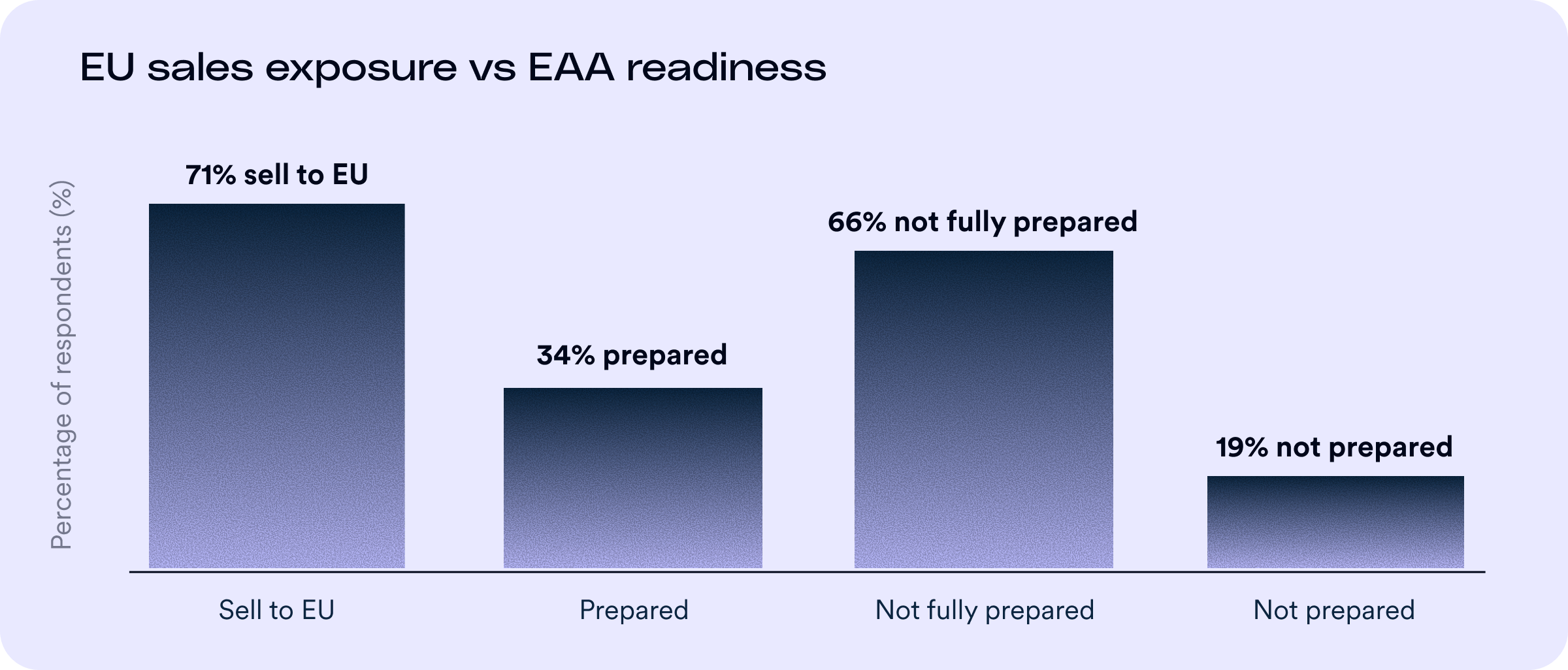About the research
Our eCommerce trends survey - conducted with Qualtrics, non-profit leaders, and disability community organizations - captured insights from over 300 eCommerce leaders and members of the disability community. The findings reveal how legal, financial, and reputational pressures are shaping accessibility priorities in 2025, with litigation and regulatory exposure, increasingly high cart abandonment rates, and the need to be optimized for AI discoverability emerging as the most urgent challenge for retailers.
The landscape every eCommerce leader must navigate
Online retail is at a turning point. Lawsuits and regulations are intensifying, cart abandonment continues to drain billions in potential sales, and voice and AI are reshaping how shoppers discover and buy products online. These aren’t just fun features anymore. They now define the competitive landscape, determining who gets ahead and who falls behind.
What ties them all together is accessibility. It is the thread that turns compliance into resilience, friction into conversions, voice into loyalty, AI into visibility, and personalization into trust. In 2025, accessibility is not just a legal safeguard it’s essential for eCommerce success.
The trends reshaping eCommerce
The shifts in digital commerce aren’t happening in isolation; together they’re reshaping how people shop and how brands compete. Each one brings both opportunity and risk, and each one shares a common dependency: accessibility. In fact, 43% of respondents have already faced a web accessibility lawsuit or claim illustrating the importance of digital accessibility.
In this report, we examine six of the most decisive shifts for retailers in 2025:
- Litigation and regulation
- Cart abandonment
- Voice commerce
- AI chat search
- The EAA & UK regulation
- Hyper-personalization
Together, they reveal how accessibility functions as the infrastructure of eCommerce growth.
Litigation & regulatory heat: A growing legal risk
Nearly 5,000 accessibility lawsuits are projected in 2025, a 20% increase year-over-year, with 69% targeting eCommerce. Most settle out of court, but costs add up quickly, not to mention the damage a legal battle can inflict on a brand’s reputation.
As mentioned above, 43% of respondents have already faced a web accessibility lawsuit or claim. In the trend report we go more into depth on how retailers are responding to the threat of litigation.
Regulators frequently reference WCAG 2.1 AA in audits and rulings, making it the most reliable standard for retailers to follow. Treating it as a guiding framework helps brands demonstrate good faith, reduce exposure, and future-proof against evolving requirements.

For eCommerce brands, the message is simple: accessibility is no longer optional risk management—it’s the price of admission to compete globally.
For the full report, press here.
Cart abandonment: From friction to revenue recovery
While lawsuits dominate headlines, there’s another big hidden cost of inaccessibility: conversion loss. Cart abandonment averages 70%, translating to $260B in recoverable sales each year.
Our survey of eCommerce leaders revealed why these barriers persist. Nearly 1 in 4 admit assistive technologies don’t work on their checkout pages, and only 40% have conducted an accessibility audit in the past year.
When checkout forms lack labels, when errors aren’t announced, or when payment modals can’t be navigated by keyboard, shoppers don’t complain—they just leave. Accessibility failures and cart abandonment are two sides of the same coin. Checkout isn’t failing by accident—it’s failing because too few brands are testing it.

Accessible checkout doesn’t just prevent lawsuits. It directly reduces friction in the checkout process, allowing online sellers to recover lost revenue at the most decisive point in the funnel.
For the full report, press here.
Voice commerce: Accessibility innovation gone mainstream
The risk of lawsuits and cart abandonment show the risks of inaccessibility, while voice commerce demonstrates the upside. What began as an accessibility tool for independence has become a mainstream habit: nearly 50% of U.S. consumers shop by voice, with the market on track to reach $81.8B in 2025.

Our research shows that eCommerce leaders are already experiencing the benefits of voice commerce. Of those who implemented voice commerce technologies, 58% report that more than a quarter of their orders are already initiated via this channel.
This is the accessibility playbook on full display: what starts as an inclusive feature often goes on to become a consumer expectation. Just as captions moved from TV to TikTok, voice is now reshaping how people shop and setting new baselines for frictionless commerce.
| "Voice commerce is incredible because, without it, I’m often locked out of even having a chance to shop independently. With it, I gain access and a sense of freedom." - Josh Basile, Esq. Community Relations Manager, accessiBe |
For the full report, press here.
AI chat search: The new storefront
Today, nearly 1B prompts are issued daily to AI chat assistants, with 1.3B monthly referrals flowing to websites. For many shoppers, discovery begins not in a search bar but with a question to ChatGPT, Gemini, or Amazon Rufus.
In this AI-first marketplace, accessibility is essential for visibility. Structured markup, alt text, and accessible FAQs allow products to surface in conversational recommendations. Without them, your catalog risks becoming invisible to both people and machines.
Benefits of accessible AI-ready content
- Visibility & SEO: Structured markup ensures AI assistants cite your products
- Conversion: Reliable data improves trust and purchase follow-through
- Brand equity: Inclusive content strengthens reputation across audiences
- Compliance: Reduces exposure to lawsuits and regulatory penalties
Risks of inaccessible content
- Invisibility: Products won’t appear in AI chat results
- Exclusion: Shoppers with disabilities face barriers in discovery or checkout
- Reputation loss: Failing to surface signals irrelevance in an AI-first market
Our research confirms that eCommerce brands are already adapting to the increasing use of AI chat for product discovery. 74% are already adjusting product content to be AI chat-friendly, and 24% are planning to make adjustments in the future.

For the full report, press here.
The EAA & UK regulation: Compliance goes global
In June 2025, the European Accessibility Act (EAA) came into effect, requiring retailers selling into the EU to provide accessible digital experiences. 71% of eCommerce leaders surveyed by accessiBe have confirmed that they sell their products and services to the EU, and yet 85% say they are not fully prepared for EAA compliance.
Non-compliance can result in fines of up to €500,000 per violation, creating significant financial and reputational risk for global brands.

In the U.K., enforcement under the Equality Act 2010 and the Public Sector Bodies Accessibility Regulations has also intensified, with regulators signaling increased scrutiny of eCommerce sites in 2025. For international retailers, accessibility is truly a global mandate.
For brands with global ambitions, accessibility is the key to market eligibility. Compliance ensures retailers can compete in Europe and the U.K., turning regulation into a growth opportunity rather than a barrier.
For the full report, press here.
Hyper-personalization: Truly personal means accessible
The next competitive frontier is personalization. 71% of shoppers expect it, and 61% will spend more with brands that deliver. But personalization that adapts to what a shopper sees without adapting to how they access it isn’t truly personal—it’s exclusion.

Accessible personalization unlocks loyalty: screen-reader friendly menus, simplified flows for neurodiverse shoppers, and user-controlled display adjustments ensure every customer can engage with tailored experiences. However, according to our research, 20% of eCommerce leaders admit they are not sure how to personalize effectively for shoppers with disabilities.
For the full report, press here.
Accessibility: The unifying thread
The trends shaping eCommerce today — stricter regulation, conversion challenges, the rise of AI and voice, and consumer demand for personalization — all come back to one foundation: accessibility. It isn’t a compliance afterthought or a niche initiative. It is the infrastructure that determines whether these trends work in your favor or against you.
Accessibility delivers benefits on every front:
- It manages risk: With lawsuits accelerating and regulations like the EAA already enforceable, accessibility is the single strongest defense. Each barrier removed eliminates evidence a plaintiff could use in court, while proof of accessible practices demonstrates good faith to regulators. This isn’t just legal cover; it’s resilience.
- It recovers revenue: The same accessibility fixes that satisfy WCAG standards are the ones that remove checkout friction, reduce abandonment, and enable more customers to complete purchases. At scale, this translates into billions in reclaimed revenue that would otherwise be lost.
- It drives visibility: In both AI chat search and voice commerce, discoverability depends on structured, accessible content. If your catalog can’t be parsed by assistive technologies, it also won’t be parsed by AI systems. Accessibility ensures your products are visible in the channels that matter most for the future.
- It builds loyalty and trust: Accessibility isn’t just about compliance or convenience; it’s about inclusion. A hyper-personalized journey that works for every customer signals respect, reliability, and innovation. In an era where brand trust drives purchase decisions, accessibility has become a core marker of reputation.
- It strengthens brand equity: From public accessibility statements to inclusive design choices, accessibility shows that your brand doesn’t just chase trends — it sets the standard for responsible, future-proof commerce.
Accessibility transforms risk into resilience, friction into revenue, and emerging channels into growth engines. It doesn’t sit alongside these trends. It powers them.
Actionable checklist for eCommerce leaders
- Audit for risk, continuously
- Run accessibility scans before every major release, promotion, or seasonal update
- Test checkout, product search, filters, and payment flows with assistive technologies
- Use both automated tools and manual audits to catch issues that AI alone can’t identify
- Design accessibility in from the start
- Bake WCAG 2.1 AA standards into design and development cycles
- Avoid the patch-and-break cycle of retrofits, which is costly and unstable
- Use accessible design patterns for forms, buttons, menus, and modals to prevent recurring failures
- Test with real users
- Involve shoppers with disabilities in user testing to uncover barriers internal QA misses
- Run usability labs that compare default flows and personalized flows
- Integrate community feedback into product roadmaps
- Optimize the checkout journey
- Simplify steps, reduce unnecessary fields, and enable guest checkout
- Ensure every input field has a label, error states are announced, and flows are fully keyboard operable
- Validate payment gateways with screen readers, keyboard navigation, and voice input
- Prepare for AI & chat discoverability
- Structure product data with semantic HTML, alt text, schema, and FAQs
- Enrich product detail pages with specifications and contextual metadata
- Test how your catalog surfaces in AI assistants (e.g., ChatGPT, Gemini, Perplexity, Amazon Rufus)
- Be voice-ready
- Add rich metadata and ARIA attributes so voice assistants can parse product data
- Provide text fallbacks for customers who can’t or don’t want to use voice
- Validate flows with screen readers and speech recognition tools to ensure parity
- Make personalization inclusive
- Ensure dynamically generated layouts, recommendations, and promotions use semantic markup
- Offer user-controlled adjustments like reduced motion, contrast options, and text resizing, such as those available with accessWidget
- Track personalization ROI alongside accessibility metrics to measure true inclusivity
- Balance automation with expertise
- Use AI-powered audits and remediation for speed and scale
- Pair with manual remediation for complex issues like modal behavior, interactive widgets, or custom code
- Try out manual intervention or user testing for high-risk areas like checkout flows
- Document and disclose
- Keep records of audits, fixes, and testing logs
- Publish an accessibility statement on your site to demonstrate transparency and good faith
- Be prepared to share evidence with regulators, partners, or courts if challenged.
- Assign ownership and accountability
- Designate a single leader (for example within Security, Product, Legal, or CX) who owns accessibility strategy
- Integrate accessibility KPIs into product and compliance reporting
- Educate teams across design, engineering, and marketing on accessibility fundamentals.
- Frame accessibility as growth, not compliance
- Position accessibility internally as a driver of conversion, SEO, brand trust, and market eligibility
- Use accessibility improvements as talking points in investor, partner, and customer communications
- Track both avoided costs (lawsuits, fines) and captured upside (higher conversion, loyalty, EU market entry)
The decisive advantage
Litigation is accelerating, cart abandonment continues to drain revenue, voice commerce is moving into the mainstream, AI chat search is becoming the new storefront, and hyper-personalization has shifted from differentiator to baseline. Together, these forces are reshaping the competitive landscape of eCommerce.
What determines whether they become opportunities or risks is accessibility. It turns compliance into resilience, friction into conversions, voice into loyalty, AI into visibility, and personalization into trust. The brands that treat accessibility as infrastructure will not only protect themselves from lawsuits and regulation but also position themselves to capture growth in the channels that matter most.
In a market defined by rapid change, accessibility is the decisive advantage in who wins the future of eCommerce.
Frequently asked questions about eCommerce trends and accessibility
Q1. What major trends are reshaping e-commerce in 2025?
A1. Key trends include rising litigation and regulation, high cart abandonment rates, voice commerce becoming mainstream, AI-chat search and discovery, global accessibility laws (such as the European Accessibility Act), and hyper-personalised shopping experiences.
Q2. Why is accessibility now considered central to e-commerce success, not just compliance?
A2. Accessibility is the connective thread across these trends: it reduces friction (helping convert carts), enhances discovery by AI, enables voice and personalised experiences to work for all users, and ensures you meet legal and regulatory obligations across jurisdictions. Without accessibility, these trends create risk rather than opportunity.
Q3. How does accessibility impact cart abandonment and conversion?
A3. Inaccessible checkout or product flows drive abandonment: if users cannot operate interfaces with keyboard or assistive tech, they leave. By fixing barriers (e.g., proper labels, keyboard operability, error announcements), accessibility directly improves conversions and revenue.
Q4. What role does AI-chat search and structured data play in accessible e-commerce?
A4. As shoppers increasingly use conversational AI and voice assistants to find products, accessible content (semantic markup, alt-text, structured data) enhances discoverability. Inaccessible or unstructured product data means your catalogue may be invisible to AI-powered discovery.
Q5. What legal or regulatory pressures are e-commerce brands facing regarding accessibility?
A5. E-commerce is a primary target for accessibility litigation and regulation: brands selling across borders must contend with laws such as the ADA (U.S.), EAA (EU), and others. Failing to address accessibility can lead to lawsuits, fines, and reputational damage.
Q6. What should e-commerce businesses prioritise to align accessibility with these trends?
A6. They should audit key flows (product discovery, checkout, mobile/voice), ensure content and markup are inclusive, integrate accessibility into development and content workflows, document their efforts, and treat accessibility as a core element of digital strategy—not a checkbox.
Q7. How can accessiBe help e-commerce brands succeed amid these accessibility-driven trends?
A7. accessiBe offers end-to-end accessibility solutions that combine AI-powered automation, expert remediation and continuous monitoring. Their tools support scanning, structured markup optimisation for AI/voice, accessible checkout flows, global compliance readiness and documentation support—helping brands turn accessibility into a differentiator rather than a liability.
Q8. What is the “in short” takeaway for e-commerce leaders?
A8. Accessibility is no longer optional—it’s the infrastructure that enables AI, voice, personalisation, global reach and regulatory compliance to work. Investing in accessibility now means reducing risk, unlocking revenue, and building inclusive, future-ready commerce.


